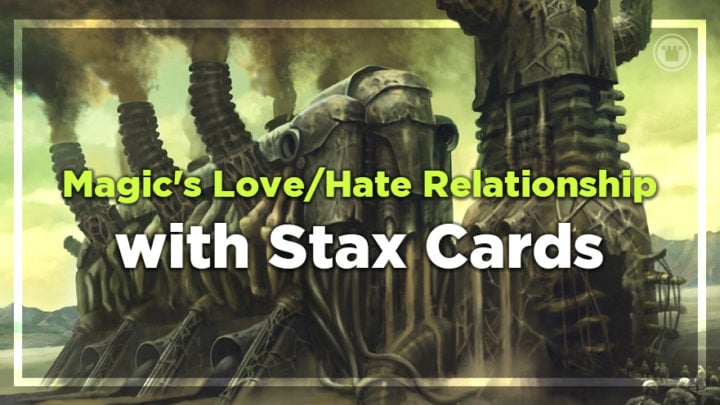Just a few weeks ago, the Magic community was excited by the spoilers from Modern Horizons 2, one of the deepest and most powerful sets of all time. We were getting huge blasts of fresh and exciting design space every few hours. There was a planeswalker you can target with Green Sun’s Zenith or Unearth, new pitch spells that you can double up with Ephemerate, and a land so powerful it made Affinity good again in Modern!
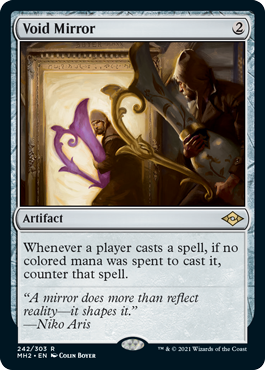
But somehow, one of the biggest reactions of the whole set was for the card Void Mirror. This straightforward, narrow sideboard tech had players worried about their decks being singled out, demanding emergency Commander bans, and bemoaning/gloating that Tron was finally dead (although that one happens during every spoiler season).
From a design perspective, this sort of “lock card” is just another type of answer that keeps certain threats in line. So, why do these cards provoke such different reactions to ordinary removal or counterspells?
THE KEY THING ABOUT LOCKS IS…
Like all Magic jargon, the definition of a “lock card” is nebulous with plenty of nuance. The core idea is that these sorts of cards restrict or lock off your opponents’ actions and choices. They are usually permanents whose restrictive effects are usually worded as static abilities — constantly applied for as long as they’re on the battlefield. They also usually balance the severity of their restrictions against their specificity — taxing a broad swathe of cards or completely blocking a specific kind of combo from going off.

Depending on context, these cards may be called “prison pieces,” “hate cards/hatebears,” “sideboard cards,” or, in some circles, “stax cards” – after the ancient Smokestack-based deck which popularized “not letting the other person play” as a strategic archetype. I find it funny that Smokestack itself is not so much a lock card by the above definition, but rather a way to capitalize on the temporary paralysis that these sorts of cards create.
But it tends not to matter to people whether the card chewing away at their life and resources is Arcbound Ravager, Lantern of Insight or Chandra, Torch of Defiance. The unique vitriol is always saved for the cards that prevent desired game actions, and only aims at the “clock” cards when the two roles cross over, as is the case with Smokestack or Hullbreacher. And I think that pretty much gives away the reason lock cards aren’t treated as “just another answer” by the player base.
ALL ABOUT AGENCY
My most reliable heuristic for when Magic is the most fun for players is “meaningful choices per minute.” The more potential I have to affect the game state, and the more options I have on when and how to do it, the better! I find Arena and MTGO less enjoyable than other forms of Magic because of how the rules engine drags out the meaningless gaps between choices. I prefer interactive midrange decks over lightning-quick linear ones, because I enjoy finding different paths to victory in each match. I have to lean hard on the social aspect of the game to enjoy multiplayer Commander as much as I do 1v1, as my share of overall turns and the impact of my individual plays are diminished.
I don’t think it’s daring of me to assume most players share this close relationship between their opportunities to act and their enjoyment of a given game. And here’s where lock cards rub those players the wrong way!
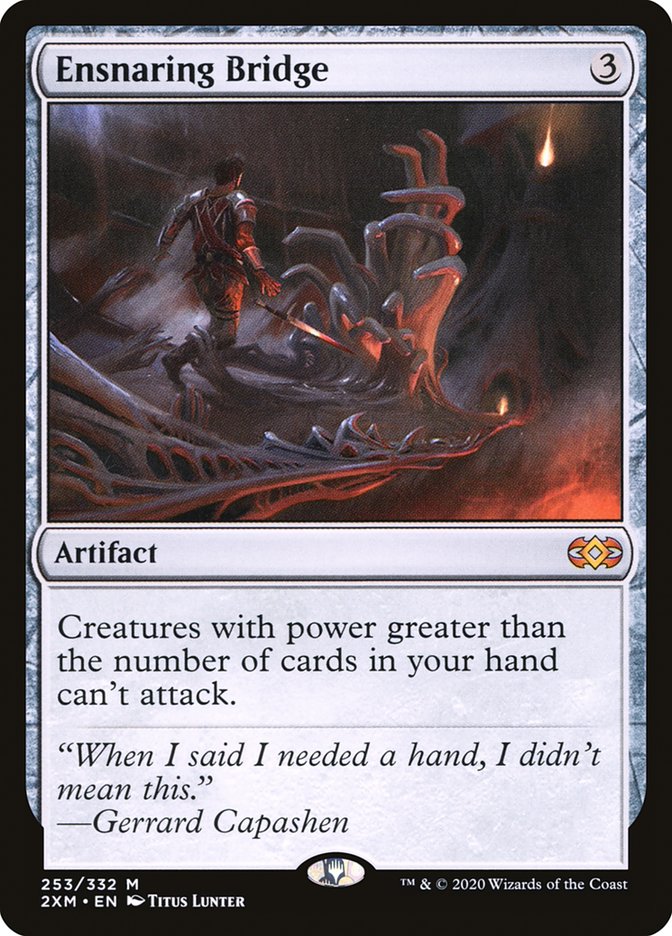
Sure, a normal removal spell or piece of countermagic might beat your card, but you already got to play it and see that line through to its conclusion. But when a lock piece shuts down your play preemptively, it does so before that choice can even become apparent, before that decision tree has the chance to entertain you with its possibilities. It also usually shuts down any future copies of the card you draw — and, in a worst-case scenario, limits your ability to dig deeper into your deck.
Now your game state has calcified around this one card, with no real actions or decisions available other than briefly checking if each draw step provides an answer to the lock. Lantern Control is the most severe example of the boredom and hopelessness a lock deck can force upon opponents, where even the hope of the draw step becomes a distant mirage.
THE GOOD SIDE OF LOCK CARDS?
The role of narrower “sideboard cards” such as Void Mirror seems more defensible than those like Ensnaring Bridge, which are common to dedicated lock decks. Sideboard lock cards usually won’t stop the opponent from drawing and playing most of their cards, and there’s plenty of interesting back-and-forth to be had trying to protect or remove them. But there are still cases where Leyline of the Void or Stony Silence turn off 75% of an opponent’s deck, or sometimes 100% before sideboards. It’s easy to argue that those players knew and accepted these risks when they decided to go all-in on dredging or artifacts. But what about when a new lock card puts players on notice, players who previously hadn’t prepared themselves for this sort of hard counter?
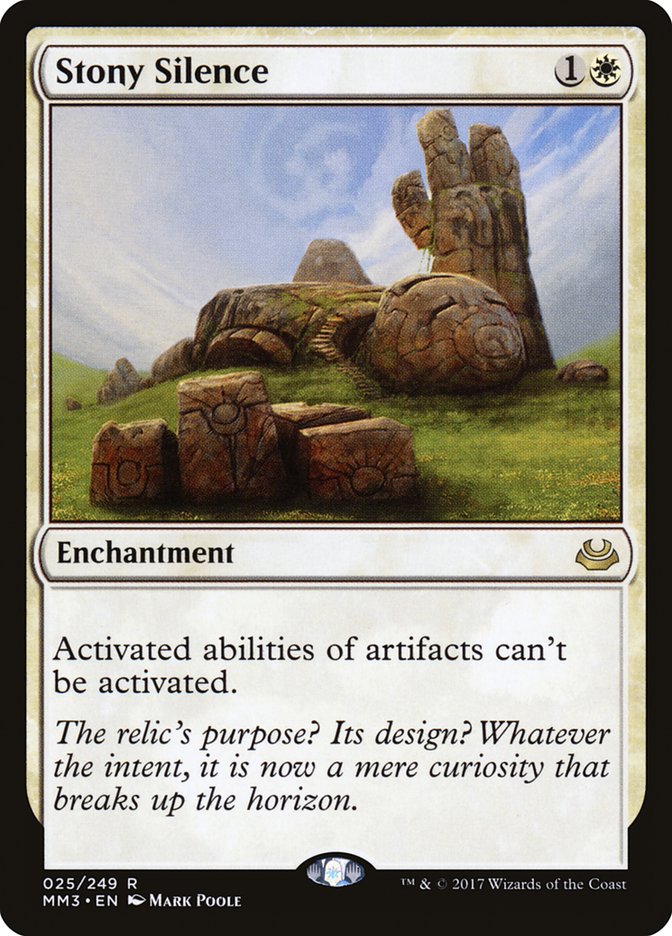
Yes, some of the hysteria around Void Mirror stemmed from the misunderstanding that it might block all casting of colorless spells. Every famous artifact deck has built-in ways to play around this card: filtering mana through Prophetic Prism or Chromatic Star, or simply producing colors with Springleaf Drum, Seat of the Synod, Spire of Industry or basic Forest. But the way this card made players feel targeted, how it caused such immediate despair and hopelessness, reminds us that lock cards are frequently the most loathed designs in Magic — even more so in Commander, where their uneven, fun-limiting potential runs directly counter to the ethos of the format.
So, why do we keep printing them?
WAR IS (WAS) HELL
Complaining about Magic cards you don’t like is the game’s oldest tradition, so it’s easy to write off loud public sentiment against Hullbreacher, Chalice of the Void, or Void Mirror as more baseless grumbling. But the metagame in both Constructed and Commander has been shifting to focus more and more on lock cards and static abilities over time, as a consequence of both power and tempo creep.

When threats are selected for their guaranteed impact on resolution, and forcing through pressure is more important than playing for card advantage, the “preemptive answer” of lock effects is usually the only viable option. The fact that many such effects are available on “hatebear” bodies (which also contribute to said pressure) allows them to see play at even higher densities.
Additionally, WotC also decided to experiment with powerful asymmetrical lock effects somewhere around War of the Spark. Not only has this created more redundancy around the common lock effects, but the asymmetrical versions are infinitely more dangerous deck building prospects now players can slot them into the same lightning-fast proactive lists they are meant to oppose.
Decks which are super-effective against themselves AND the field are a recipe for a rapidly devolving one-deck metagame. To see WotC double down by printing cards like Hullbreacher and Narset, Parter of Veils after more than four years of Leovold has made a lot of people concerned, to say the least. But at the same time, if we banned every lock card tomorrow, the game would almost certainly be worse off — swamped by aggressive brute force combo decks abusing the most uninteractive, explosive lines beyond the ability of any “fair” deck to react.
WHEN LOCK CARDS BECOME BAND-AIDS
And therein lies the systemic issue, which has led us down this path where oppressive lock cards are a necessary refuge for many players. In Commander and other non-rotating formats, the proactive synergy and combo decks inevitably grow more powerful over time, as incremental upgrades and redundant options for their plan are printed. Because no answer in Magic can efficiently cover all the angles of attack available, any linear proactive deck will have the edge in Game 1; every card in their deck was chosen to create maximum pressure at a single point, while opposing draws might not address that specific pressure efficiently – or at all.

Targeted hate cards have been the accepted balancing factor for most of Magic history. They create a vital incentive for decks to be less one-dimensional by providing unbeatable efficacy against a specific line of play. But there’s no obvious requirement for these to come in the form of lock cards. Red and Blue Elemental Blast have been key factors in eternal Magic since Alpha, while Surgical Extraction, Containment Priest and Hurkyl’s Recall provide ways to deal with the most common unfair strategies through the stack. Even static lock effects can draw widespread applause for interesting gameplay, when they’re of the softer, taxing variety, a la Thalia, Guardian of Thraben or Kambal, Consul of Allocation.
But unfortunately, it doesn’t matter how much more efficient your one-for-one sideboard answers are if your opponent is able to run you out of them and combo off! And when outright victory is at hand, the only relevant tax on your opponent is one that’s beyond their means to pay. With proactive decks faster than ever — wielding redundant threats designed to trade well against removal, while also demanding it — “fair” decks must lean more heavily on strict lock cards to stay alive while maintaining resource efficiency.
YOU DON’T MAKE FRIENDS WITH LOCKS
This is just as true in Commander as in Modern or Legacy – if not more. The high life totals and multiplayer focus of the format make combo wincons a near-necessity, while the deck building rules incentivize heavy focus on a narrow line of synergy. Given the power of the eternal card pool and the way color ID rules limit available answers, a preemptive lock card like Grafdigger’s Cage, Null Rod or Trinisphere will often be your sole line of defense against well-tuned opposition.
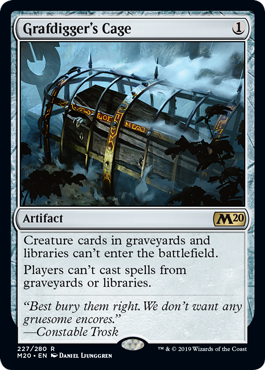
But due to the fun-first culture of the format, shutting down someone’s ability to play their cards — even if it’s partly a consequence of that opponent’s deck building choices — is heavily stigmatized. For players who frequent the same playgroups with the same decks week after week, introducing lock cards which target only one deck at the table will inevitably be taken as personal, even if just within the politics of “threat assessment.” Sleeving up these sorts of cards can feel like the start of a spiteful arms race, where players without the resources to change commanders regularly are sitting ducks against spells never balanced for main-decking against known opposition.
As always, Commander groups benefit from Rule Zero and the chance to choose their own future — whether it’s one ruled by degenerate combo, brutal lock cards, or (hopefully) a respectful mutual restraint. But the pressure on them — not to mention players of other Constructed formats — is only mounting set after set.
LOCKING DOWN A SUSTAINABLE METAGAME
In the short term, I think WotC can improve things just by immediately vetoing future asymmetric lock cards. They’re much riskier than cards that affect all players, from a balance perspective, and less interesting from a deck building perspective. While there’s some ingenuity in the way Hullbreacher/Narset players can weaponize Echo of Eons to end a game, the way asymmetrical effects wreck otherwise balanced cards could end up curtailing the design space available to future sets.
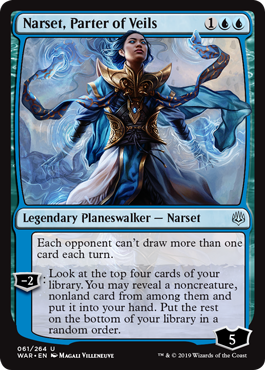
In seriousness though, there is a good chance that R&D have already made the call to end this unfortunate experiment. Stretches of time have been incredibly hard to parse lately, but Narset was only printed 18 months before Hullbreacher — and, lest we forget, new cards are usually designed at least that far in advance. As sick as we all are by now of being locked under these effects plus “draw-sevens,” we’re only just starting to reach a point where past-WotC would have been able to react to that feedback. And telltale signs like Sheldon Menery’s recent article seem to indicate that they accept the community’s judgment of these powerful asymmetrical effects.
In the long term, though, diminishing the presence of agency-limiting lock cards will require a broad re-calculation of how WotC designs for and balances Constructed formats. Since some sort of mass-banning is about as likely as physically unprinting the problem cards, we will need to introduce cards which are equally as powerful, but on a different strategic axis. The MH2 “pitch” Elementals — flexible answers that trade cards for mana to cancel out opposing tempo plays — are a great positive example. Following these up with a few more hate cards to position all-in linear decks as high-risk, high-reward will hopefully nudge the most polarizing examples — and their even more polarizing answers — out of the spotlight.

Tom’s fate was sealed in 7th grade when his friend lent him a pile of commons to play Magic. He quickly picked up Boros and Orzhov decks in Ravnica block and has remained a staunch white magician ever since. A fan of all Constructed formats, he enjoys studying the history of the tournament meta. He specializes in midrange decks, especially Death & Taxes and Martyr Proc. One day, he swears he will win an MCQ with Evershrike. Ask him how at @AWanderingBard, or watch him stream Magic at twitch.tv/TheWanderingBard.

